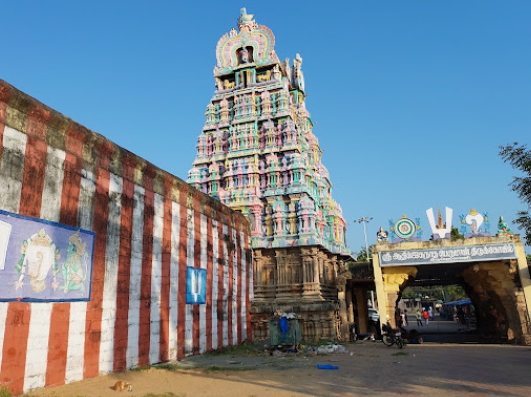Approximately 72 Chatur Yugas ago (countless crores of years), three sages—Pullavar, Kannavar, and Kalavar—arrived in the region now known as Thiruppullani. At that time, the area was densely covered with darbha grass. The sages engaged in deep penance, and, pleased with their devotion, Lord Vishnu appeared before them in the form of a Bodhi tree (Arasa Maram). The sages, however, sought the divine grace of Vishnu in His original form. Lord Vishnu complied, manifesting as Lord Aadhi Jagannatha. This event marked the place now known as Thiruppullani. A shrine for Mother Padmasani was later established here. Additionally, it is believed that Emperor Dasaratha came here to learn the mantra for a child boon and was blessed with Lord Rama and his brothers as his sons.
Sthalapuranam of Adi Jagannatha Perumal Temple :
In the Ramayana, when Ravana abducted Sita and took her to Lanka, Lord Rama sought to rescue her. Ravana's brother, Vibheeshana, opposed this act and advised Ravana to return Sita to Rama to avoid impending danger. Ravana, angered by Vibheeshana's counsel, expelled him from Lanka. Vibheeshana then sought refuge at the feet of Lord Rama, informing Him of Sita's captivity. This act of surrender by Vibheeshana is why this place is called "Saranagathi Kshetram."
While in Thiruppullani, Rama performed penance on darbha grass for seven days to seek divine aid. This act, known as "Darbasayanam," gave the place its name. Rama worshipped Aadi Jagannatha Perumal and prayed for assistance to rescue Sita. Pleased with Rama’s devotion, Aadi Jagannatha Perumal granted him a bow, leading to the deity being known as "Deivasilaiyar."
The temple is located near Sethu Karai (shore), where Rama needed to cross the ocean to reach Lanka. Vibheeshana suggested that Rama could compel the ocean to dry up to make way for his army. Rama then prayed to the Samudra Raja (ocean god) for a path, and when no response was forthcoming, He threatened to dry up the ocean. Frightened, the Samudra Raja and his consort Varuni surrendered to Rama, which is why the place is also called "Saranagathi Kshetram."
Following this, the ocean was calmed, and Rama, with the help of Nala and the Vanaras (monkey army), built a bridge known as "Sethu Anai" to Lanka. After crossing this bridge, Rama defeated Ravana and rescued Sita.
Kanva Rishi, who did intense penance at this site, was blessed by Perumal to always be present to assist Him. Another rishi, Devala Maharshi, performed tapas here, and when seven celestial maidens (deva kanyas) came to bathe in the river and were cursed by Devala Maharshi for their lack of respect, they sought redemption from Pullar Maharishi at Thiruppullani. Pullar Maharishi advised them to worship Aadi Jagannatha Perumal to overcome their curse. When Lord Rama arrived, He saw the deva kanyas, and they were freed from the curse and returned to their celestial abode.
In this temple, Lord Rama is depicted in a reclining posture on darbha grass. Unlike the usual depiction on Adisesha (the serpent bed), here He rests on the grass, with Lakshmana, who is considered the incarnation of Adisesha, by His side. The Utsava Murthy (procession deity) is Kothanda Rama, accompanied by Sita, Lakshmana, and Hanuman. A separate shrine for Pattabhi Rama commemorates Rama's coronation as king of Ayodhya.
There is also a shrine for Sandhana Gopalan, where worship of Krishna as a child on Adisesha is believed to help with conception. This deity is offered milk payasam (sweet milk porridge) nightly. Pilgrims visiting Rameswaram often worship at Thiruppullani to seek blessings. Near the main shrine, a large banyan tree houses several Shiva Lingams, and it is believed that dedicating these Lingams can assist with pregnancy.
